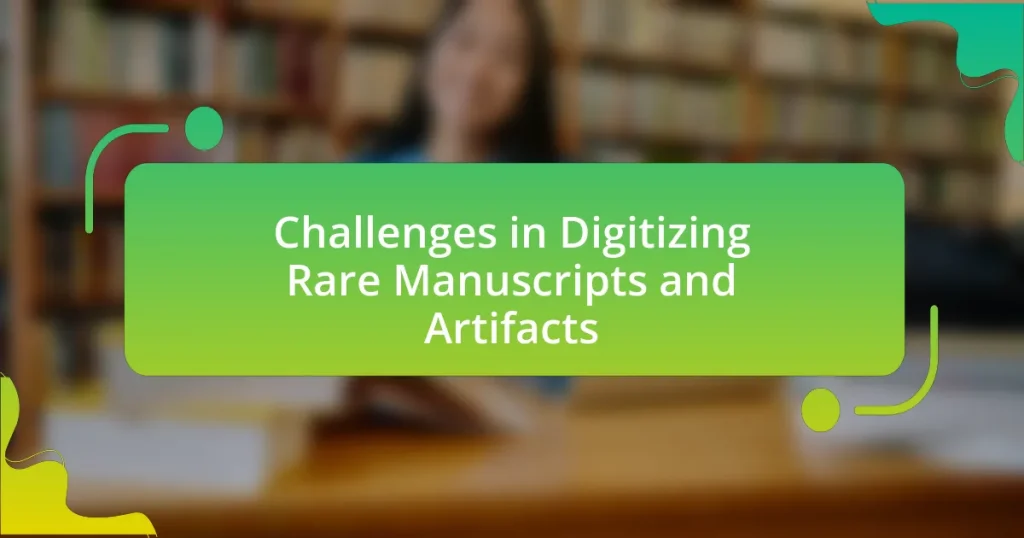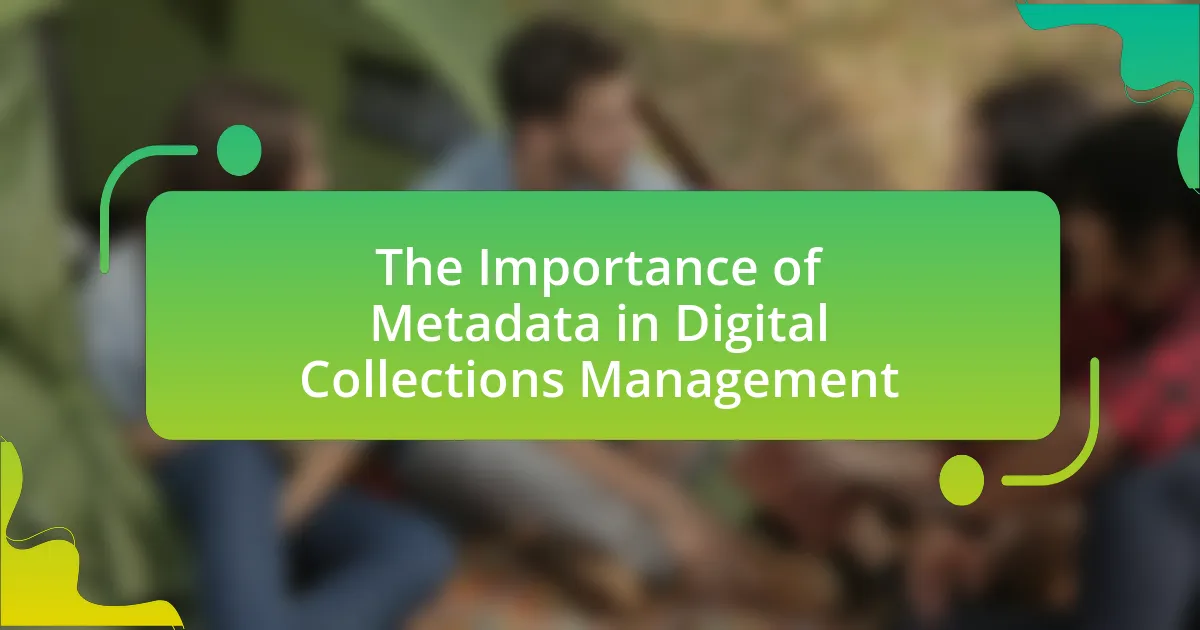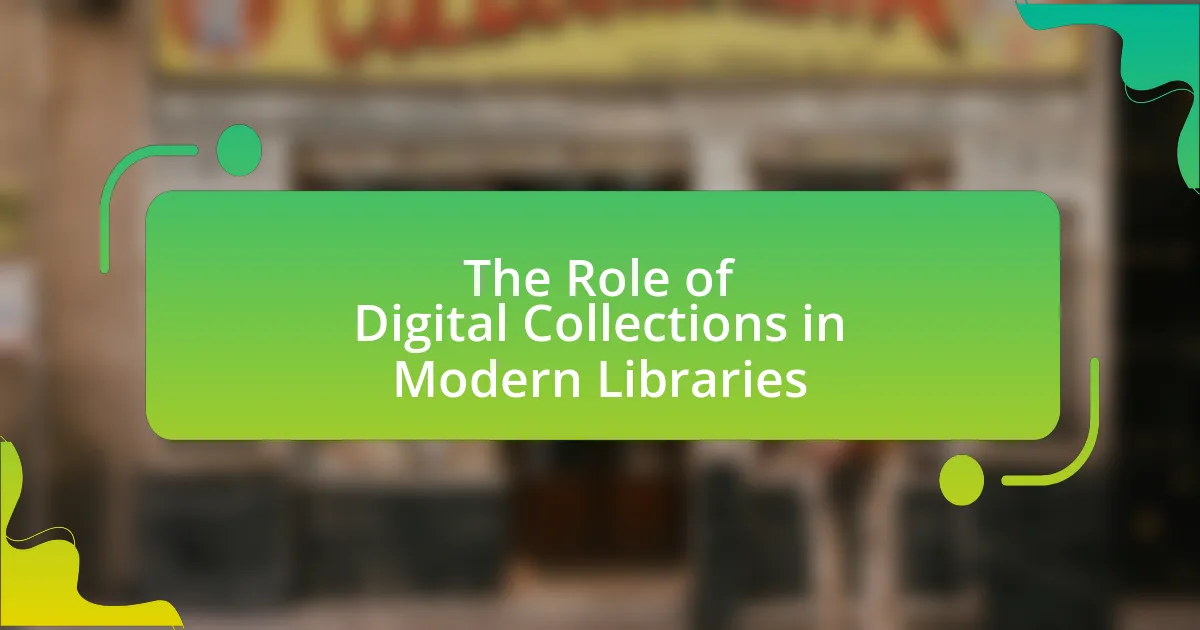The article focuses on the challenges associated with digitizing rare manuscripts and artifacts, highlighting key issues such as preservation concerns, technical limitations, and accessibility challenges. It emphasizes the importance of digitization for preserving fragile materials and enhancing public access while addressing the ethical considerations surrounding ownership and cultural sensitivity. The article also discusses the necessary equipment, environmental conditions, and funding strategies required for successful digitization projects, along with best practices to ensure high-quality outcomes. Overall, it provides a comprehensive overview of the complexities involved in the digitization process and the implications for cultural heritage preservation.
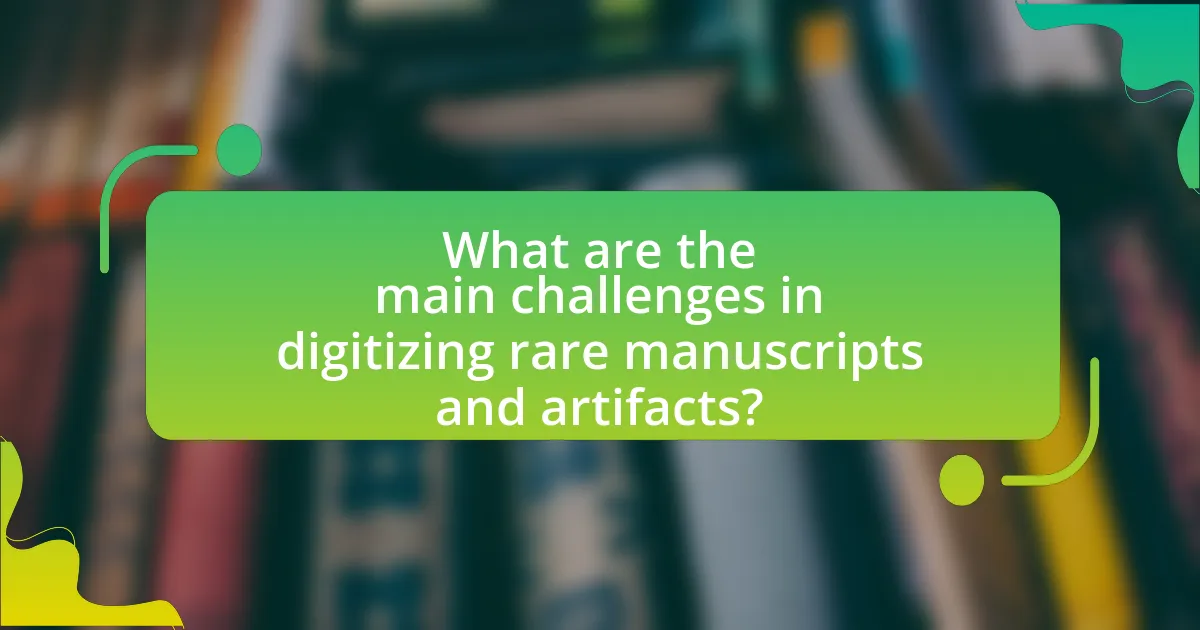
What are the main challenges in digitizing rare manuscripts and artifacts?
The main challenges in digitizing rare manuscripts and artifacts include preservation concerns, technical limitations, and accessibility issues. Preservation concerns arise because many rare items are fragile and can be damaged during the digitization process, necessitating specialized handling and equipment. Technical limitations refer to the need for high-resolution imaging and advanced software to accurately capture and represent the details of these items, which can be costly and require expertise. Accessibility issues involve ensuring that digitized materials are made available to a wider audience while also protecting copyright and intellectual property rights, which can complicate distribution. These challenges highlight the complexity of balancing preservation, technology, and access in the digitization process.
Why is digitization important for rare manuscripts and artifacts?
Digitization is important for rare manuscripts and artifacts because it preserves their content and makes them accessible to a wider audience. By converting physical items into digital formats, institutions can protect these fragile materials from deterioration caused by handling and environmental factors. For instance, the British Library’s digitization project has made over 1 million items available online, allowing global access while safeguarding the originals. This process not only enhances preservation but also facilitates research and education, ensuring that valuable cultural heritage is maintained for future generations.
What role does preservation play in the digitization process?
Preservation is essential in the digitization process as it ensures the longevity and integrity of rare manuscripts and artifacts. By preserving these items before digitization, institutions can prevent deterioration and damage that may occur during the scanning or photographing process. For instance, the Library of Congress emphasizes that proper handling and environmental controls are crucial to maintain the physical condition of historical documents, which directly impacts the quality of the digital representation. Furthermore, preservation strategies, such as using acid-free materials and climate-controlled storage, support the creation of high-quality digital archives that accurately reflect the original items, thereby enhancing accessibility and research opportunities.
How does digitization enhance accessibility to rare manuscripts and artifacts?
Digitization enhances accessibility to rare manuscripts and artifacts by converting physical items into digital formats that can be easily accessed online. This process allows a broader audience, including researchers, students, and the general public, to view and study these items without the limitations of geographical location or the constraints of physical preservation. For instance, institutions like the British Library have digitized millions of pages of manuscripts, making them available to anyone with internet access, thereby increasing engagement and educational opportunities. Furthermore, digitization helps preserve the original items by reducing the need for physical handling, which can lead to deterioration.
What technical challenges are faced during the digitization process?
The technical challenges faced during the digitization process include data quality issues, equipment limitations, and software compatibility problems. Data quality issues arise when original manuscripts and artifacts have deteriorated, making it difficult to capture accurate digital representations. Equipment limitations refer to the inability of scanners and cameras to handle the unique sizes and materials of rare items, which can lead to incomplete or low-resolution images. Software compatibility problems occur when digitized files cannot be easily integrated into existing systems or when the software used for digitization does not support the required file formats, hindering accessibility and usability.
What equipment is necessary for digitizing rare manuscripts and artifacts?
To digitize rare manuscripts and artifacts, essential equipment includes high-resolution scanners, digital cameras, and specialized lighting systems. High-resolution scanners, such as flatbed or overhead scanners, capture detailed images without damaging fragile materials. Digital cameras, particularly those with high megapixel counts and macro capabilities, allow for photographing three-dimensional artifacts and delicate details. Specialized lighting systems, including LED lights and diffusers, ensure even illumination to prevent glare and shadows, which can obscure important features. This combination of equipment is critical for preserving the integrity and detail of rare manuscripts and artifacts during the digitization process.
How do image quality and resolution impact the digitization of artifacts?
Image quality and resolution significantly impact the digitization of artifacts by determining the clarity and detail captured in digital representations. High image quality and resolution allow for accurate reproduction of intricate details, textures, and colors, which are essential for preserving the authenticity of rare manuscripts and artifacts. For instance, a study by the Library of Congress indicates that digitizing at a minimum of 300 DPI (dots per inch) is necessary to ensure that fine details are not lost, which is crucial for scholarly research and public access. Conversely, low image quality and resolution can lead to misinterpretations and a loss of valuable information, undermining the purpose of digitization. Therefore, the choice of image quality and resolution directly influences the effectiveness of digital archives in preserving cultural heritage.
What ethical considerations arise in the digitization of rare manuscripts and artifacts?
Ethical considerations in the digitization of rare manuscripts and artifacts include issues of ownership, consent, and cultural sensitivity. Ownership concerns arise when determining who has the rights to digitize and distribute the content, especially when artifacts belong to indigenous or marginalized communities. Consent is critical, as stakeholders must agree to the digitization process, particularly when cultural heritage is involved. Cultural sensitivity is paramount to avoid misrepresentation or exploitation of the artifacts, ensuring that the digitization process respects the cultural significance and context of the materials. These considerations are essential to uphold ethical standards in preserving and sharing cultural heritage.
How do copyright issues affect the digitization process?
Copyright issues significantly hinder the digitization process by imposing legal restrictions on the reproduction and distribution of copyrighted materials. These restrictions can prevent institutions from digitizing rare manuscripts and artifacts, as they must navigate complex copyright laws that vary by jurisdiction and may require obtaining permissions from copyright holders. For instance, the U.S. Copyright Act protects original works for the life of the author plus 70 years, which means many works remain under copyright long after their creation, complicating access for digitization efforts. Additionally, the risk of legal repercussions for unauthorized digitization can deter institutions from undertaking projects that could otherwise enhance public access to cultural heritage.
What are the implications of cultural sensitivity in digitization projects?
Cultural sensitivity in digitization projects implies that understanding and respecting the cultural contexts of the materials being digitized is crucial for ethical and effective preservation. This sensitivity ensures that the digitization process honors the cultural significance of artifacts, which can prevent misrepresentation and promote accurate representation of diverse histories. For instance, projects that digitize Indigenous manuscripts must engage with the communities involved to ensure that their perspectives and rights are respected, as seen in initiatives like the British Library’s collaboration with Indigenous groups in Australia. Such collaborations not only enhance the authenticity of the digitized content but also foster trust and support from the communities, ultimately leading to more successful and inclusive digitization efforts.
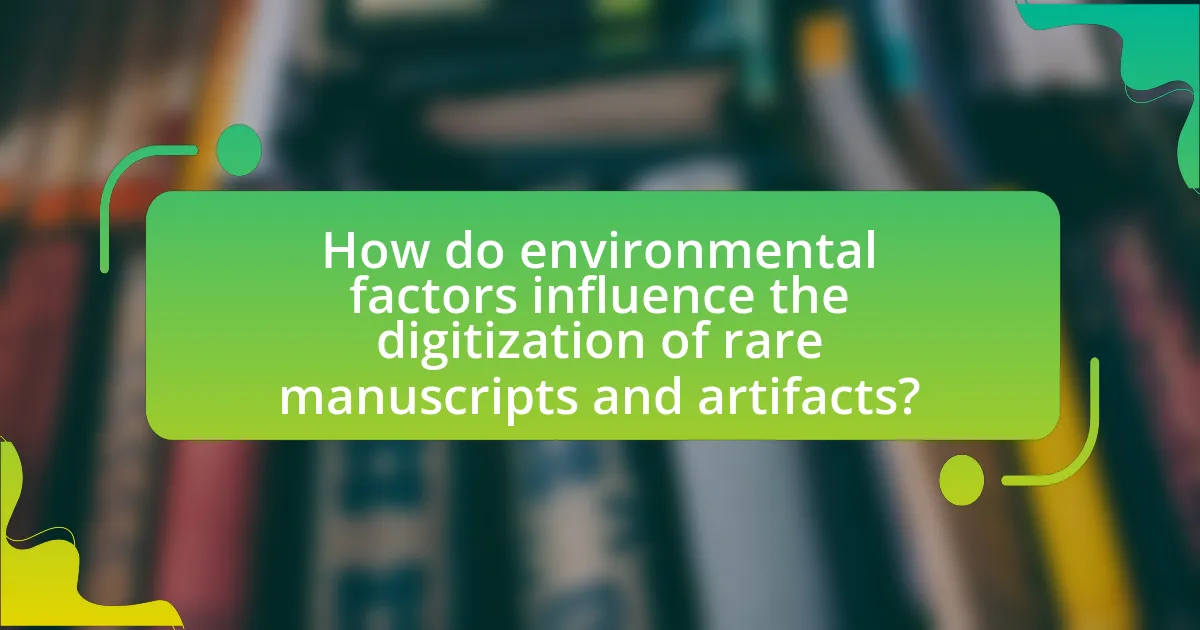
How do environmental factors influence the digitization of rare manuscripts and artifacts?
Environmental factors significantly influence the digitization of rare manuscripts and artifacts by affecting their preservation and accessibility. High humidity, temperature fluctuations, and exposure to light can deteriorate physical materials, making them more challenging to digitize without causing damage. For instance, the Library of Congress notes that manuscripts stored in environments with high humidity can develop mold, which compromises their integrity and usability. Additionally, the presence of pollutants can lead to chemical reactions that degrade paper and ink, further complicating the digitization process. Therefore, maintaining optimal environmental conditions is crucial for the successful digitization of these valuable items.
What environmental conditions are critical for preserving manuscripts and artifacts during digitization?
Critical environmental conditions for preserving manuscripts and artifacts during digitization include stable temperature, controlled humidity, and protection from light exposure. Maintaining a temperature between 18-22 degrees Celsius and relative humidity levels of 30-50% helps prevent deterioration and mold growth. Additionally, minimizing exposure to UV light and using appropriate lighting conditions during digitization reduces the risk of fading and damage. These conditions are supported by guidelines from institutions like the Library of Congress, which emphasize the importance of environmental control in the preservation of cultural heritage materials.
How does humidity affect the condition of rare manuscripts during digitization?
Humidity significantly affects the condition of rare manuscripts during digitization by influencing their physical integrity and stability. High humidity levels can lead to mold growth, paper deterioration, and ink bleeding, which compromise the manuscript’s legibility and preservation. Conversely, low humidity can cause paper to become brittle and prone to cracking, making handling and digitization risky. Studies have shown that maintaining relative humidity levels between 30% and 50% is optimal for preserving the condition of rare manuscripts, as this range minimizes the risk of both mold and brittleness, ensuring that the manuscripts remain stable and intact throughout the digitization process.
What temperature controls are necessary to protect artifacts during the process?
Temperature controls necessary to protect artifacts during the digitization process include maintaining a stable environment typically between 18°C to 22°C (64°F to 72°F) with low humidity levels of around 30% to 50%. These conditions prevent deterioration caused by fluctuations in temperature and moisture, which can lead to mold growth, warping, or fading of materials. Research indicates that consistent temperature and humidity levels significantly extend the lifespan of sensitive artifacts, as fluctuations can accelerate degradation processes.
What role does funding play in the digitization of rare manuscripts and artifacts?
Funding is crucial for the digitization of rare manuscripts and artifacts as it provides the necessary resources for technology, expertise, and preservation efforts. Without adequate financial support, institutions may struggle to acquire the advanced scanning equipment and software required for high-quality digitization. For instance, projects like the British Library’s “Endangered Archives Programme” demonstrate how funding enables the preservation of at-risk materials through digitization, allowing broader access and safeguarding cultural heritage. Additionally, studies indicate that digitization projects often require significant investment, with costs ranging from thousands to millions of dollars, depending on the scope and complexity of the materials involved. Thus, funding directly impacts the success and sustainability of digitization initiatives.
How can institutions secure funding for digitization projects?
Institutions can secure funding for digitization projects by applying for grants from government agencies, private foundations, and cultural organizations. For example, the National Archives and Records Administration offers grants specifically for digitization efforts, while organizations like the Mellon Foundation provide funding for projects that enhance access to cultural heritage. Additionally, institutions can collaborate with technology companies for sponsorships or partnerships, leveraging their resources and expertise to support digitization initiatives. Engaging in community fundraising campaigns and utilizing crowdfunding platforms can also attract financial support from individuals interested in preserving cultural heritage.
What are the financial implications of high-quality digitization?
High-quality digitization has significant financial implications, primarily by reducing long-term costs associated with physical preservation and increasing accessibility to rare manuscripts and artifacts. By investing in high-quality digitization, institutions can minimize the need for costly conservation efforts, as digital copies can alleviate wear and tear on original items. Furthermore, digitization can enhance revenue streams through online access fees, virtual exhibitions, and increased visitor engagement, leading to higher attendance and donations. A study by the Digital Preservation Coalition indicates that institutions that digitize effectively can see a return on investment through improved operational efficiency and expanded audience reach, ultimately justifying the initial financial outlay.
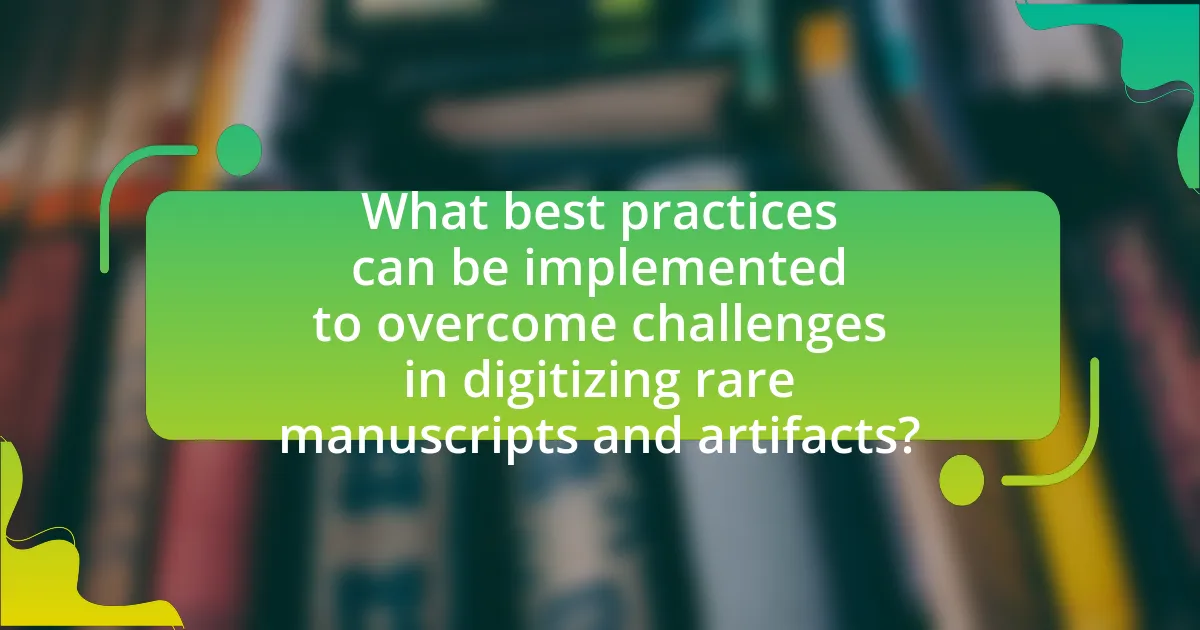
What best practices can be implemented to overcome challenges in digitizing rare manuscripts and artifacts?
Best practices to overcome challenges in digitizing rare manuscripts and artifacts include employing high-resolution imaging techniques, utilizing controlled environments for preservation, and implementing robust metadata standards. High-resolution imaging captures intricate details, ensuring that digital representations maintain the quality of the original artifacts. Controlled environments, such as climate-controlled storage, protect sensitive materials from deterioration during the digitization process. Additionally, robust metadata standards facilitate accurate cataloging and retrieval, enhancing accessibility and usability of the digitized materials. These practices are supported by studies indicating that high-quality imaging and proper preservation techniques significantly improve the longevity and usability of digital collections.
How can institutions ensure the quality of digitization projects?
Institutions can ensure the quality of digitization projects by implementing standardized protocols and best practices throughout the digitization process. These protocols should include thorough planning, which involves assessing the condition of the materials, selecting appropriate equipment, and defining metadata standards. For instance, the Library of Congress has established guidelines that emphasize the importance of using high-resolution imaging and consistent file formats to maintain the integrity of the digital representations. Additionally, conducting regular quality control checks during and after the digitization process helps identify and rectify any issues, ensuring that the final digital products meet established quality benchmarks.
What standards should be followed for digitization processes?
The standards that should be followed for digitization processes include adherence to established guidelines such as the ISO 19264 for digitization of cultural heritage materials and the Federal Agencies Digital Guidelines Initiative (FADGI) which provides technical specifications for digital imaging. These standards ensure high-quality digital representations, preservation of original materials, and accessibility for future use. For instance, ISO 19264 emphasizes the importance of capturing the full detail of manuscripts and artifacts, while FADGI outlines specific metrics for resolution, color accuracy, and file formats to maintain integrity during the digitization process. Following these standards helps mitigate challenges associated with digitizing rare manuscripts and artifacts, ensuring that the digital versions are reliable and usable for research and public access.
How can collaboration with experts enhance digitization efforts?
Collaboration with experts enhances digitization efforts by providing specialized knowledge and skills that improve the quality and efficiency of the process. Experts in fields such as archival science, digital imaging, and conservation can offer insights into best practices for preserving the integrity of rare manuscripts and artifacts during digitization. For instance, a study by the Digital Preservation Coalition highlights that involving conservators in the digitization process can lead to better preservation outcomes, as they understand the material properties and potential risks associated with different digitization methods. This collaboration ensures that digitization not only captures the content but also maintains the physical and historical significance of the items being digitized.
What are common troubleshooting tips for digitization projects?
Common troubleshooting tips for digitization projects include conducting thorough pre-digitization assessments, ensuring proper equipment calibration, and implementing quality control measures throughout the process. Pre-digitization assessments help identify potential issues such as the condition of the materials and the appropriate digitization methods, which can prevent complications later. Proper equipment calibration ensures that the digitization process captures accurate colors and details, which is crucial for preserving the integrity of rare manuscripts and artifacts. Quality control measures, such as regular checks and validations of digitized outputs, help maintain high standards and address any discrepancies immediately. These practices are essential for successful digitization, as they mitigate risks associated with the preservation of valuable historical items.
How can institutions address technical failures during digitization?
Institutions can address technical failures during digitization by implementing robust backup systems and regular maintenance protocols. These measures ensure that data is not lost during technical disruptions and that equipment remains functional. For instance, employing redundant storage solutions can safeguard against data corruption, while routine checks on digitization equipment can prevent malfunctions. Research indicates that institutions that adopt comprehensive risk management strategies, including contingency planning, experience fewer disruptions in their digitization processes.
What strategies can be employed to manage budget constraints in digitization projects?
To manage budget constraints in digitization projects, organizations can implement strategies such as prioritizing high-impact items, leveraging open-source technologies, and seeking partnerships or grants. Prioritizing high-impact items ensures that resources are allocated to the most valuable manuscripts or artifacts, maximizing the return on investment. Leveraging open-source technologies can significantly reduce software costs while still providing robust tools for digitization. Additionally, seeking partnerships with academic institutions or cultural organizations can provide access to funding and expertise, as evidenced by successful collaborations in projects like the Digital Public Library of America, which has effectively utilized grants to support digitization efforts. These strategies collectively enhance the efficiency and effectiveness of digitization projects within budgetary limits.
